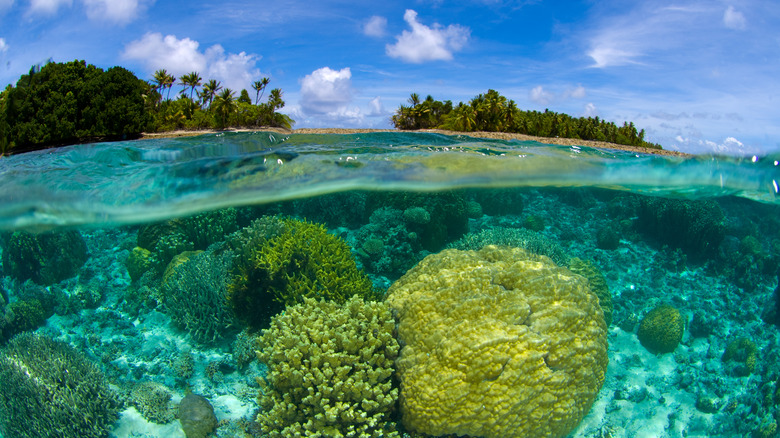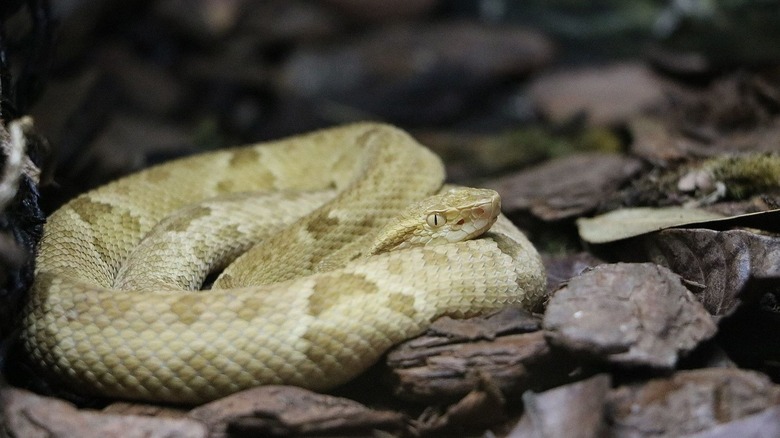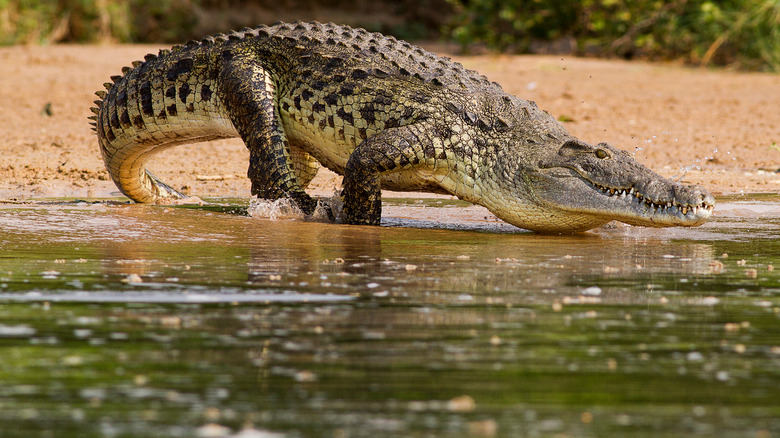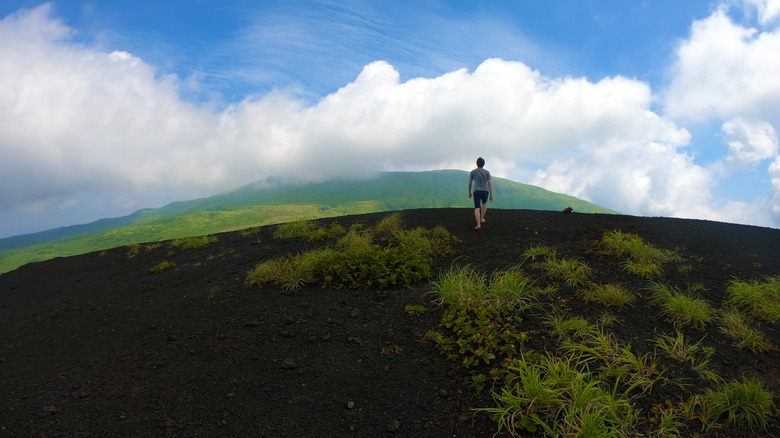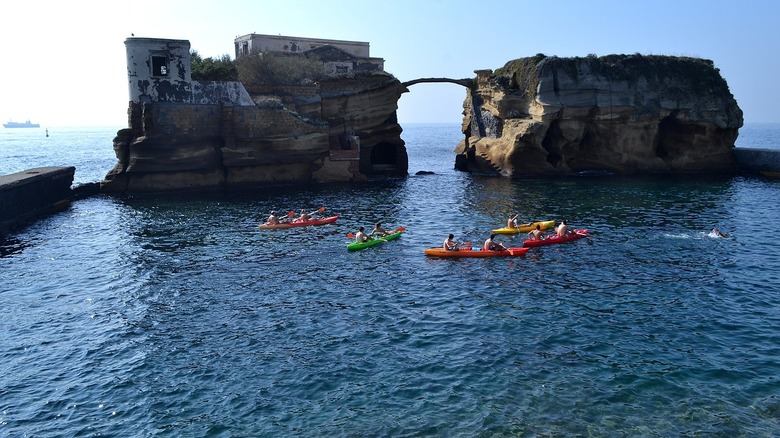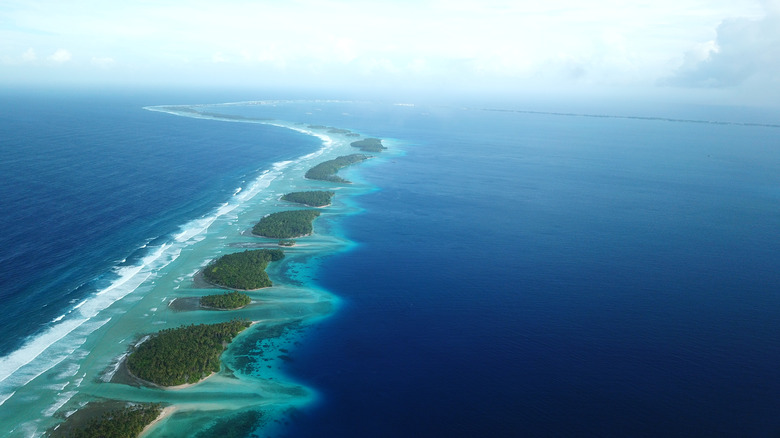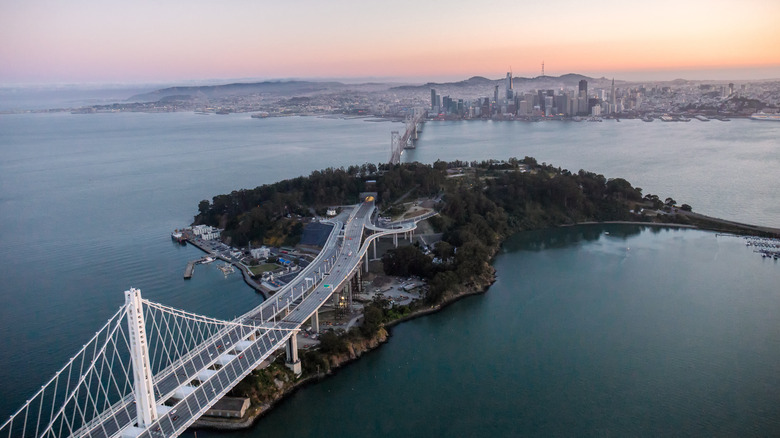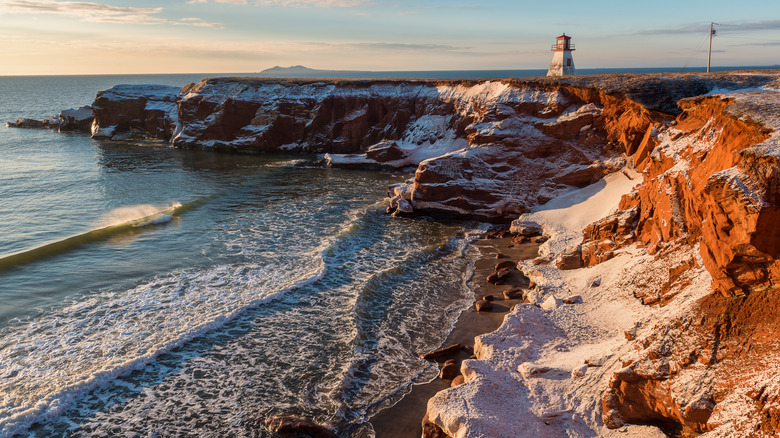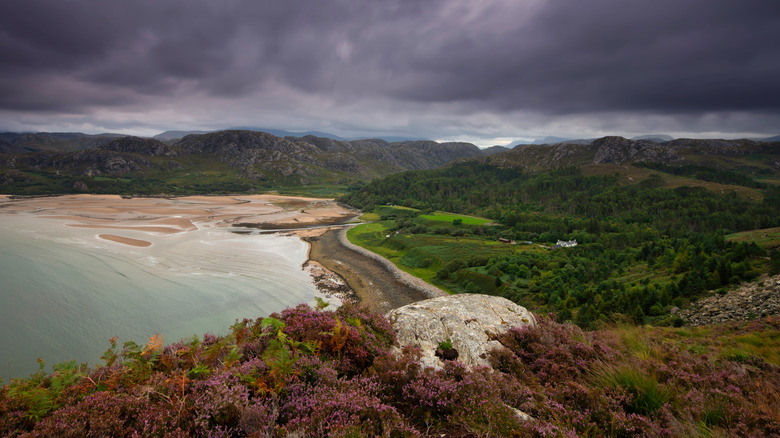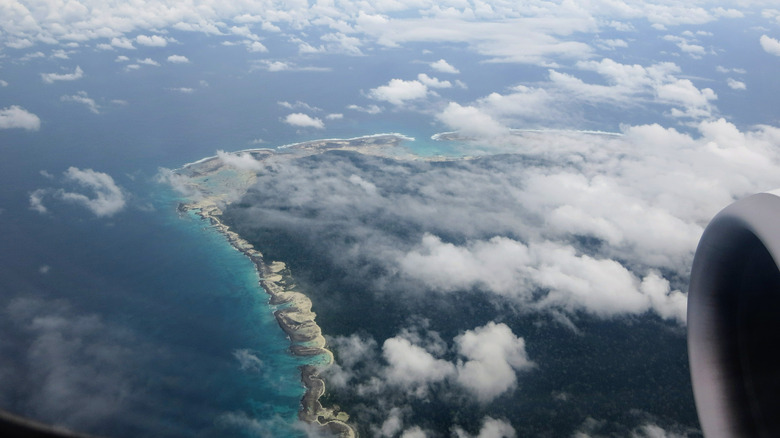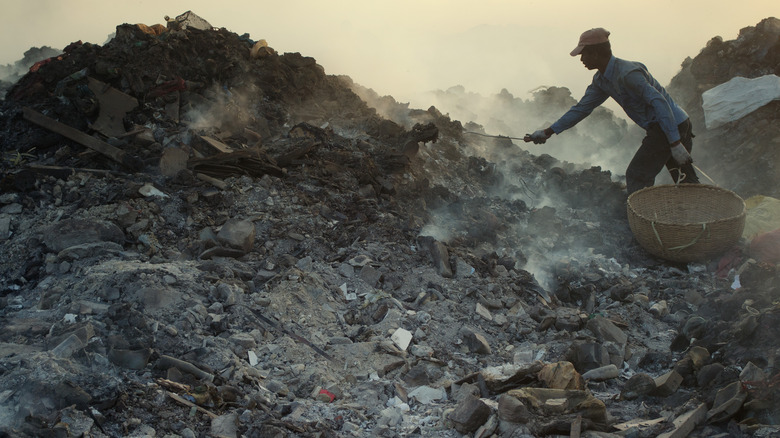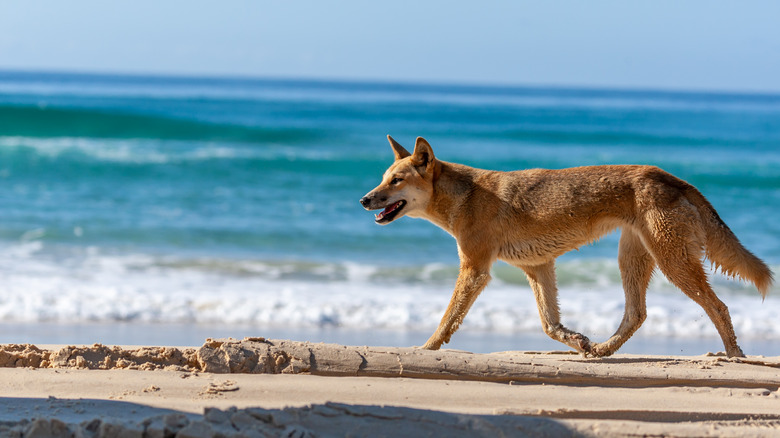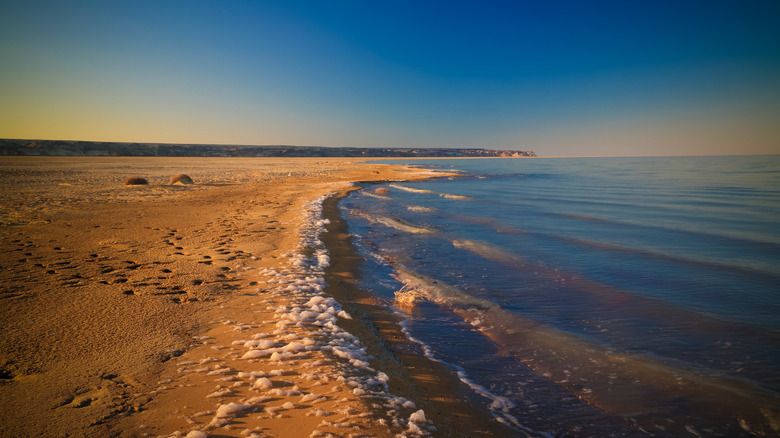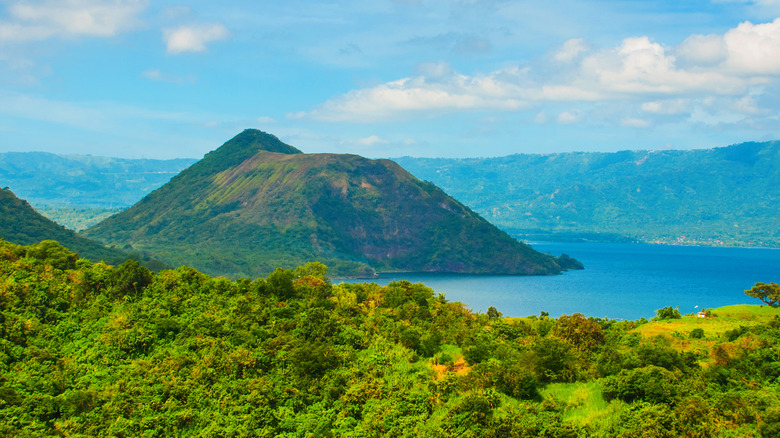The Most Dangerous Islands On Earth
Ever since the TV show "Lost" captured our imaginations and had us tuning in week after week, we've all had a bit of a healthy respect for anyone who suddenly finds themselves stranded on a mysterious island filled with unseen dangers. And here's the thing: Islands like that really are out there. The world is a super weird place, and there's islands that are covered with things like deadly animals, and filled with things like deadly chemicals both manmade and natural. How about an island that's rumored to be cursed, and has verifiable evidence to back that up? That's real, too.
And if there's anything you can say for sure about some of the most dangerous islands in the world, it's that they're more terrifying than, say, violent cities, dangerous rivers, or even the most dangerous gangs in the world. Why? For one simple reason.
There's only so far you can run, before you can't run any further.
Snake Island crawls with skin-melting snakes
The idea of snakes so deadly they can melt human skin with their venom sounds like something out of a horror novel written by an 11-year-old, but sometimes, truth is stranger than fiction. The snakes are golden lancehead vipers, and there are thousands of them living on the island properly called Ilha da Queimada Grande, but more popularly known as Snake Island. The island is about 90 miles off the coast of Brazil, and honestly? That's not far enough.
According to Smithsonian, one bite from any of the 2,000 to 4,000 snakes on the island will quite easily kill a person within the hour, and the next logical question is, "Why on earth are these snakes a thing?" The island was actually connected to the mainland around 11,000 years ago, and when sea levels changed and isolated an island population, they not only reproduced with no predators to keep them in check, but they also evolved a venom so strong that prey didn't have a chance to fly away before dying. Yikes.
The Brazilian government has made the island off-limits to everyone but researchers with special permits, and that's okay. That venom causes things like muscular necrosis, hemorrhaging of the brain and intestines, and considering there's around one snake for every square meter, no one wants to go there anyway.
This island has a taste for human flesh
If Ramree Island was any closer to the coastline of Myanmar (Burma), it wouldn't be an island anymore. It's separated by just a thin line of water, and that's not nearly enough. Why? It's home to an unnecessarily large population of prehistoric, dinosaur holdovers. We are, of course, talking about crocodiles.
Keep these not-so-fun facts in mind: crocodiles can grow up to 20 feet in length, weigh 2,000 pounds, and have the most powerful bite of any animal that's ever been tested. It's not clear how many of these ancient killing machines live on Ramree Island, but the answer is, "A lot," and one group of Japanese soldiers found out firsthand how dangerous they are.
It started on January 26, 1945, with British troops who were trying to set up a supply base on the island. Defending Japanese forces retreated into the island's swamps, and of the roughly 1,000 men who headed into the mangrove swamp, about 20 were later captured, and 500 were never seen again. Survivors told horrible stories of their fellow soldiers turned crocodile victims in feeding frenzies that swept through the entire croc population, with one writing (via History Net): "... the blurred worrying sounds of spinning crocodiles made a cacophony of hell that has rarely been duplicated..."
Sun tan lotion? Check. Scuba gear? Check. Gas mask? Check.
Miyake-Jima is undeniably beautiful, and it sits in the Pacific Ocean just off the coast of Japan. Specifically, it's in an area known as the Devil's Sea, and The Travel says it's sort of the Pacific's version of the Bermuda Triangle. Should that dissuade visitors? Maybe not, but the requirement that everyone on the island be prepared with a gas mask at all times just might.
The danger here comes from the active volcano that residents share their island with, and to clarify, it isn't just an active volcano, it's erupted six times since the turn of the 20th century. That, says NASA, includes an eruption in June of 2000 that forced the evacuation of all 3,600 residents.
The evacuation order was lifted in 2005, and 10 years later, life was pretty much back to normal... with the exception of a continued mandate about the gas masks. (Tourists can pick one up at most shops, notes Atlas Obscura.) Those masks have to be ready to go at all times, because island-wide alarms could sound at any moment, indicating the volcano is leaking a potentially toxic amount of sulfur dioxide into the air, and everyone had better button up if they'd like to keep breathing.
The island that might make you believe in curses
Curses are the stuff of mythology and Stephen King novels, but there's one island off the coast of Italy that just might make a believer out of the staunchest cynic: Isola della Gaiola. Let's start with the rumored incidents.
There are a lot, especially considering the island has been inhabited since the Roman era. Fast forward quite a bit, though, and the shady stuff really kicks off in the early 19th century with a lone inhabitant called Il Mago. That translates to "the Wizard," and one day, he simply vanished. Subsequent owners suffered from tragedy after tragedy, including financial ruin, a mysterious disappearance amid a shipwreck, murder, and accidental drownings. Is there a "next?" Of course! That was a pharmaceutical industrialist who ended up completing suicide after being committed to an asylum.
There's two more widely documented stories regarding the island. It was owned by Gianni Agnelli of Fiat fame, who ended up suffering from terrible personal tragedies that included the suicide of his son and the loss of a young nephew to cancer. Then, it belonged to the Getty family, who had so much horrible luck that there are rumors of having their own family curse. It's not entirely surprising that the Italian government decided to cut their losses, take over the island, and turn it into a marine reserve.
If you or anyone you know is having suicidal thoughts, please call the National Suicide Prevention Lifeline at 1-800-273-TALK (8255).
The Pacific paradise ruined by nuclear testing
At one time, the Marshall Islands were incredibly beautiful. They're still gorgeous, but now, they're also highly radioactive thanks to a series of 67 nuclear tests performed across the various islands between the years of 1946 and 1958. These were no small bombs, either: According to CNN, if you were to combine all nuclear testing that the US did during those years, more than half of the nuclear energy was dumped on this Pacific paradise.
Those that had called the Marshall Islands home were forcefully removed, and after spending years being shuttled from one place to another, they were allowed to return home. And yes, there's a massive "but."
In 2019, scientists from Columbia University were studying the amount of radiation that still remained, and found (via LiveScience) that decades after the tests ended, some places contained levels of plutonium between 10 and 1,000 times higher than levels found in the areas around the nuclear reactor meltdown on Fukushima. For another comparison, the islands still had radiation levels 10 times higher than what's found at Chernobyl. Even the fruit grown on the island was highly radioactive, and bottom line? That means we've ruined the Marshall Islands.
Here's why full disclosure is pretty important
In 1940, San Francisco hosted the Golden Gate International Exposition. There's a lot of construction that goes into an event that big, and this one included the building of a man-made island that was named Treasure Island. After the exposition, it ended up being commandeered by the US Navy. According to ABC News, the naval station closed in 1997, the city bought the island back, and started redeveloping it into housing estates.
All that's fine and dandy, but in 2020, residents of Treasure Island filed a $2 billion lawsuit against the Navy, San Francisco, and California. Why? A lack of full disclosure.
During the Cold War, Treasure Island had been a training center: Military personnel were trained in "decontamination," and the end result was a ton of radioactive materials — like cesium-137 and radium — getting dumped on the island and left. Curbed San Francisco says that "basketball-sized chuck[s] of low-level radioactive dirt" have been found buried beneath homes, along with "radioactive radium discs and flakes of metal." Consequently, residents say they've suffered from unnaturally high rates of illnesses from asthma and thyroid issues to cancers. California Department of Public Health radiation safety officer Gaetano Taibi summed it up like this (via Reuters): "They never should have allowed anyone to live there."
The island populated by the descendants of shipwreck survivors
The Magdalen Islands lay in the middle of the Gulf of St. Lawrence, and they're technically a part of Quebec. They also have a fascinating history: According to the BBC, nearly all the residents on the islands today are descended from the men and women who survived shipwrecks in the island's shallow, rocky waters. And there were a lot. It's estimated that somewhere between 500 and 1,000 ships wrecked on and around the island, with most of them smashed on the rocks in the 18th and 19th centuries as they carried European travelers to the New World in search of a better life.
Amusing Planet says there's a whole host of factors that made sailing around the Magdalen Islands a risky move. Many maps didn't show the islands yet, making their appearance out of the foggy, stormy weather a complete surprise to many captains. There were also no lighthouses, and the fact that since the island's sands are prone to shifting, it's difficult to tell where the land ends and safety begins.
Today, the islands are home to around 12,000 people, and while some of the shipwrecks can still be seen, others were repurposed into buildings that still stand. Residents are almost completely isolated, and when the waters around their island freeze, there's no way off or on.
It's said to be safe... but residents still doubt
In 1941, the British government kicked off a new initiative called Operation Vegetarian, and the goal was to develop a deadly biological weapon for use against the Axis powers. The very peculiar idea that formed was one where so-called "cattle cakes" would be dropped on the livestock that Germany relied on, and researchers hoped that by poisoning millions of animals with anthrax, it would disrupt the food supply and bring the war to an end.
The Ministry of Defense said, "Yea, let's try that," and according to The Press and Journal, the Scottish island of Gruinard was purchased, sheep were taken to the island by the boatload, herded into the so-called "exposure zone," and then bombarded with anthrax bombs. Unsurprisingly, they all died. (On a side note, the project was a go, but by the time the five million anthrax-filled cakes were made, the war was over. They were destroyed.)
Gruinard was quarantined for a while, but when some of those original, highly toxic sheep started washing up on the mainland, it was clear there was something deadly on the island. When a terrorist cell in the 1980s claimed to have gotten anthrax-contamination soil from the island and was ready to ship it to their various targets, the government set about cleaning it up... although not everyone believes they made it completely safe.
They really just want to be left alone... and who can blame them?
There's an invisible border around North Sentinel Island, says Travel + Leisure — go within three miles of it, and you're officially in a territory that's been made off-limits by India. Why? The island is home to a group of people who really, really just want everyone from the outside world to stay away.
First contact came in the 19th century, when a merchant ship found itself stranded on the coral reef. Three days later, the indigenous people made it very clear that they weren't welcome, and while the castaways survived to be rescued by another passing ship, relations haven't gotten any better. As recently as 2018, The Guardian reported that an American man who ignored the warnings was killed after he paid fishermen to drop him off near the island: They reported they saw him get shot with an arrow before he was taken into the jungle.
There have been a few friendly encounters with members of the tribe, including a very cautious meet-and-greet in 1991, when National Geographic says anthropologists were able to gift coconuts to the islanders without dying. Still, Forbes says that India stopped all anthropological visits in 1996, after a few less friendly encounters. The end result is that while the outside world knows almost nothing about the people on North Sentinel island, that seems to be the way they like it.
The toxic, man-made island of the Maldives
When it comes to beautiful — and endangered — places on Earth, the Maldives gets a frequent mention. This South Asian paradise is pretty much everything that most of us dream of experiencing for our retirement years, but there's one island that doesn't make it into most photos. That's Thilafushi, otherwise known as Rubbish Island.
The BBC says that the artificial island is pretty much made of garbage, and in 2011, there was so much of it that it was spilling out into the water around it... partially because the boats employed to shuttle garbage from luxury hotels and other tourist hotspots had been choosing to just dump their trash in the water instead of wait in long lines.
While the island employs locals to theoretically sort garbage and recycle what they can, it's just too much to handle. The result, says Phys, is piles and piles of garbage that are burned, releasing toxic fumes into the air — as well as into the water. That's everything from beer bottles to batteries, and the Environmental Justice Atlas sums up the island of garbage, toxic smoke, and leaking hazardous waste like this: "Walking around Thilafushi is hellish."
Australia has a super-dangerous beach, because of course they do
Culture Trip says that Australia's Fraser Island has one of the most dangerous beaches in the world, and there's actually a lot of really good reasons to think twice about visiting this piece of gorgeous paradise on Earth... starting with the jellyfish.
Anyone thinking of wading in the waters off Fraser Island should watch out for the Blue Bottles, which are distinctively colored jellyfish also known as the Portuguese Man o' War. According to Discover Hervey Bay, they sting somewhere around 10,000 people every year. (And yes, they travel in groups, so that's fun.) Those same waters are also home to Great White sharks that are attracted by the nearby whaling plants, and then there's also 18 different types of snakes (with six being incredibly venomous), and hundreds of dingoes, which are wild dogs that are completely adorable but potentially dangerous.
Now, add in rough, unpredictable waters prone to rip tides, the zero lifeguards that are on duty, and a super weird favorite pastime that All About Fraser says can go very badly, very quickly. Running down sand dunes and diving into the island's freshwater lakes leave people crippled — and even quadriplegic — every year.
The eerie reminder of Soviet germ warfare
Today, the BBC says that the Aral Sea is only about a tenth of the size it was back in the beginning of the 20th century — and at the time, it was the 4th largest freshwater lake on the globe and a bustling hub for the fishing industry. Areas that were once islands aren't completely surrounded by water anymore, and that includes Vozrozhdeniya. While curiosity-seekers could walk to the one-time island these days, that's not a great idea: In the 1970s, the then-island was the site of a series of Soviet experiments in germ warfare.
The top-secret facility was identified only as Aralsk-7... to the few people who were in-the-know. It was "a bioweapons program on an industrial scale," and there was a shocking number of diseases researched in what was an open-air site: anthrax, the plague, smallpox, typhus... you name it, they were testing it.
Occasionally, those germs escaped, including smallpox and the plague transmissions in a span of two years in the early 1970s. Fast forward to 1988, and that's when 50,000 antelope grazing nearby died... in a single hour.
When the BBC profiled a team that headed into the heart of the complex in 2017, they reported that their gas masks were overloaded with toxic materials in just 15 minutes, and they had to leave.
A little volcano that can do a lot of damage
Ben Kennedy, a physical volcanology professor at the University of Canterbury, describes Taal (via the BBC) as "a baby volcano sitting within a much bigger caldera volcano," and if there's one thing that's not better in nesting-doll form, it's volcanoes. And this one? It's erupted around 35 times since the 19th century, including one 1911 eruption that killed 1,300 people.
The whole setup is pretty weird: Vulcan Point Island sits in the middle of Crater Lake, which is on Volcano Island, which is in the middle of Taal Lake. Even though seismic activity has, in recent years, led to regular draining of Crater Lake (via The Washington Post), the presence of the water near a volcano presents yet another danger to those living nearby: The risk of the volcano setting off a tsunami — and yes, around half a million people live within nine miles of the whole shebang. Why? Everything that's come spitting out of the volcano has created fertile farmland in the surroundings areas, and... is it worth the risk? Only the people who live there really, truly know.
